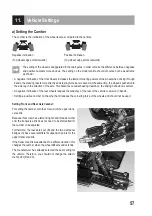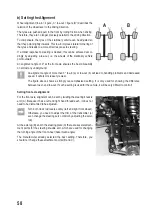
43
8. Charging the Batteries
a) Charging the Drive Batteries for the Vehicle
• The model is delivered without any drive batteries. They must be purchased separately. You can chose whether you
want to use low-cost battery packs for beginners or high-quality professional battery packs with a high capacity.
• High-quality drive batteries not only have a higher capacity, which allows you to drive your model vehicle much
longer, but also deliver a higher output voltage under load. This gives the motor more power and results in better
acceleration and higher speed.
• The drive batteries are usually delivered uncharged and must be charged. Several complete discharge and charge
cycles are necessary before the drive battery delivers its maximum power.
• Only use a charger suitable for LiPo batteries.
We recommend purchasing a high-quality charger. This should always have an installed balancer (frequently also
called an „Equalizer“). Otherwise, an external balancer is required.
The balancer measures the voltage of every single cell of the LiPo rechargeable battery during charging and pre
-
vents that different cell voltages result.
Different cell voltages lead to an overcharge of individual cells when charging LiPo batteries; there is a
danger of fire and explosion! When discharging, a different cell voltage leads to deep discharge of individual
cells, which renders the LiPo battery unusable.
• Remove the drive batteries from the vehicle for charging.
• Rechargeable batteries heat up when charged or discharged (driving the vehicle). Wait until the rechargeable batte
-
ries have reached room temperature before charging them. The same applies after the charging procedure. Do not
use the drive batteries in the vehicle until they have cooled down sufficiently after the charging process.
b) Charging Rechargeable Batteries in the Transmitter
The included transmitter may not have a charging socket; observe the included operating instructions for the
transmitter. In this case, remove the inserted batteries and charge them externally.
If your transmitter has a charging socket, check whether there are actually rechargeable batteries inserted
in the transmitter before connecting the charger. When charging normal (non-rechargeable) batteries, there
is a risk of fire and explosion!
• We recommend not charging rechargeable batteries directly in the transmitter but with a high-quality charger for
individual cells instead.
• Rechargeable batteries in the transmitter must not be quick-charged as this damages the transmitter and heats
up the cells in the transmitter excessively. Observe the maximum permissible charging current as indicated on the
transmitter or in the operating instructions of the remote control system.
• Only use a charger designed for the respective number of cells in the transmitter and the corresponding recharge
-
able battery type.
Содержание 40 95 98
Страница 130: ...130 ...
Страница 131: ...131 ...






























